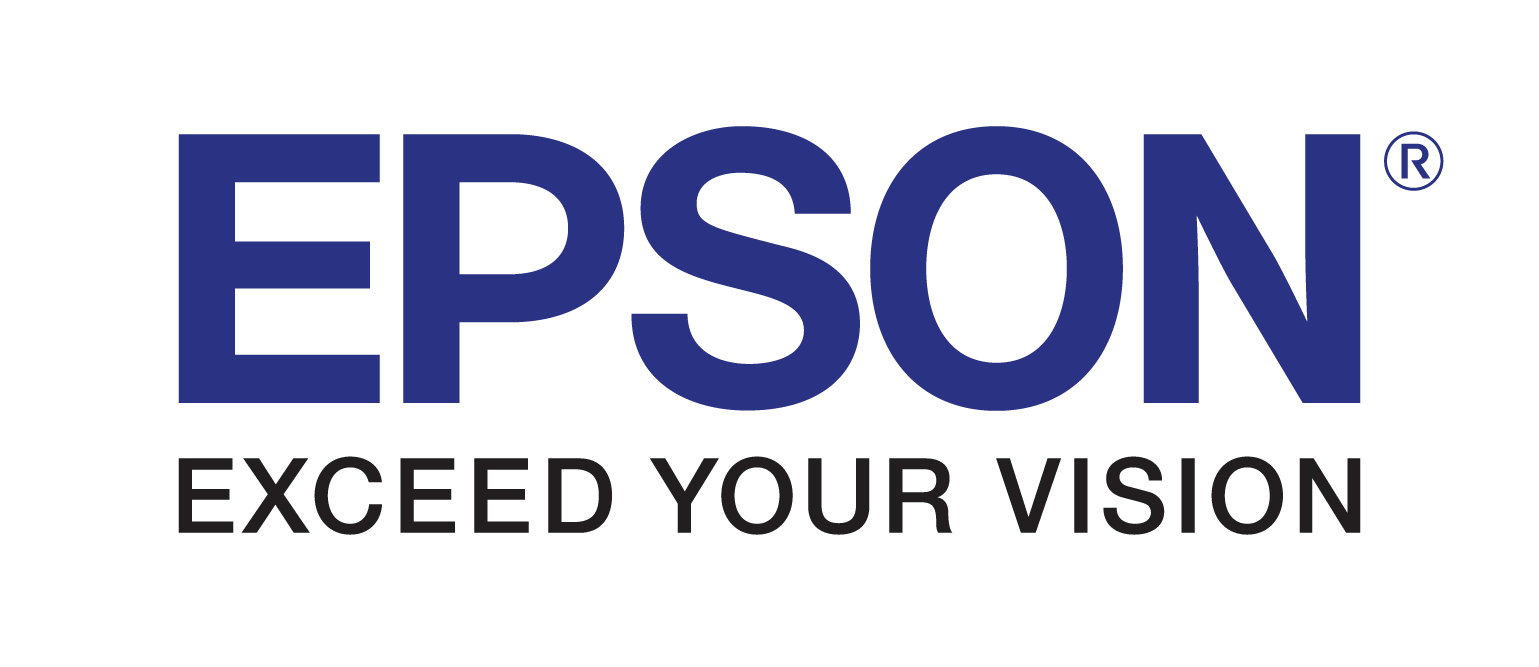
This Projector uses Epson’s MicroLaser Array and 3LCD technology to display bright, vibrant images, with a native 1080p resolution and Android TV built-in-all in a package you can easily tote around.
BY JOHN SCIACCA
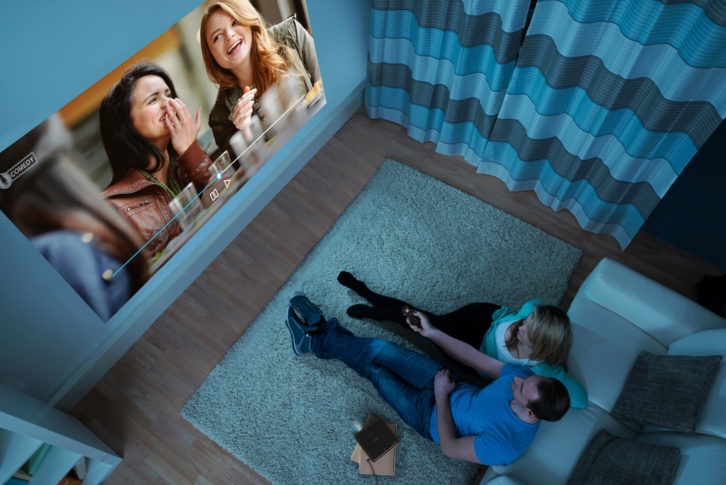
Home theatre is what got me into this industry, and it remains my passion. (Watching the movie Speed on LaserDisc on a JBL surround system at a friend’s house ended up literally changing my life, but that’s another story…) And until micro-LED or massive direct view displays really take off and reach real-world pricing, the pinnacle of the home theatre experience will include a front projector.
The projection market has certainly evolved over the years, and, like almost every video product performance has continued improving while prices have steadily dropped. While a native 4K projector still runs north of $5500 (and potentially much more), there are quite a few bargains that can be had in the sub- $2000 range with performance and ease of installation that would outshine models costing many times more from just a few years ago. (I remember agonizing over whether or not to purchase a $15,000 Runco CRT projector with 8-inch CRTs and an external line tripler. Now that unit would be destroyed in almost every metric by the majority of LED or DLP projectors on the market!)
One category that has really developed in recent years is portable projectors. This isn’t a category I had much personal experience with, and reviewing LG’s PH303N portable projector (available at residentialsystems.com) was a real-eye opener (pun-intended) on exactly how far this category has come. That micro-LG unit delivered HD (1280×720) resolution using long-lasting LEDs for the light source, could run on battery power, was small enough to toss in a backpack, and sells for under $400!
But the LG was not without some shortcomings. For one, the sound was awful, barely hitting 60 dB at 1-meter. Second, it wasn’t very bright; producing just 250 lumens (when on AC power), requiring a dark room for it be really usable. For a third, its use of Miracast for wireless streaming was hit and miss, leaving iOS users out. Finally, while it could run on battery power, eking out two hours required low-lamp (i.e., dim) mode, which robbed picture quality.
Being as it is summer, it seemed the perfect time to bring in another portable projector for review, giving me the opportunity to use the Elite Screens Yard Masters outdoor screen (review available at residentialsystems.com) I still have on hand. For this review, we decided to up the ante, selecting a model with a higher budget and performance.
Epson, Which has been a leader in the LCD projection space, has been doing a lot of work on its laser projection models, and the company had the perfect candidate in the form of its new EpiqVision Mini EF12. This unit uses Epson’s MicroLaser Array and 3LCD technology to display bright, vibrant images with a long (estimated 20,000-hour) lifespan, with a native 1080p resolution and Android TV built-in– all in a package you can easily tote around, inside or out.
Installation
Unboxing the Epson EpiqVision EF12 revels small, black, near-cube shaped device about 7 inches at its largest and weighing in under 5 pounds. The body is mostly textured plastic with a roughly 2-inch band of durable speaker mesh wrapped around the top. There are some controls on the top (five buttons total), a small lens set right-of-center on the front, with all connections on the side. While there is no lens cover, it is set back a bit inside the case to offer some protection. Along with the projector and its external power supply, the packaging includes a handheld remote and four-page Quick Setup guide. (A more thorough 120-page User’s Guide is available online).
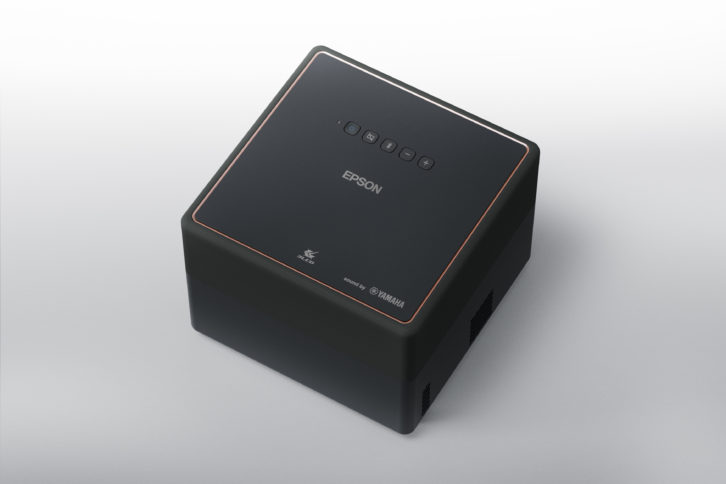
Connections are all on the side and include two HDMI (HDMI2 supports ARC), a USB Type-A, and a mini-jack output for analog audio. While the USB input will likely be used for a thumb drive filled with video files, it can also support a web cam if you wanted to use the Epson for your next Zoom call. The back of the unit is connection-free, making it easy to lay the projector on its back and point it straight up for projection on the ceiling. (something that was a real hit when my daughter’s friends came over!)
The projector has built-in Wi-Fi, supporting both 2.4 and 5 GHz connections. It also utilizes Chromecast to easily stream content directly to the projector from a phone, tablet, or computer. Android users can actually Chromecast to the device without the need for a separate Wi-Fi connection.
Image size is dictated by how far the projector is from the screen, wall, or whatever you are projecting on. The fixed lend has a throw distance almost 1:1, meaning for every inch away from the screen it produces a diagonal 16×9 image roughly that size, with an image size range of 30-150-inches. (Actually 1.13:1 is more accurate.) At 52 inches from the screen, it produces a 60-inch diagonal 16×9 image, at 88 inches it produced 100 inches, and sits 133 inches back from its full 150-inch image.
Ideally the projector sits perfectly flat and level with the lens centered horizontally on the screen and vertically positioned at the bottom of the screen. Of course, in reality- especially if you are carrying the EF12 around to other rooms, outside, to friend’s homes, or hotels, etc.– this is often way easier said than done. Trying to find a table, book, cart, or whatever that got the lens to the exact right height, position, and level to eliminate any geometry issues was often a Sisyphean task. There is a single little foot that can extend from the bottom front of the projector raising it about an inch, but since there are no leveling or feet adjustments for the back of the unit, the single front foot doesn’t really help with keeping it square and level.
Also, because of where the projector ideally needs to sit- about 80 inches back from my ceiling mounted 92-inch draper screen, for example- positioned centered and at the bottom of the screen meant anyone sitting almost anywhere behind it had a portion of the screen blocked by the projector. There is a threaded insert on the bottom for ceiling mounting the projector (and a digital image flip if it is upside down), but if you are looking for a projector for a permanent mounted installation, I daresay this Epson is not the right choice for you. This threaded insert could also take a tripod, and that would actually be worth considering.
Fortunately, digital keystone adjustments are available to help get a square image. The projector has an auto-keystone setting that can be enabled in the Settings menu that automatically adjusts keystone and focus whenever the projector is moved. However, I found this kind of sensitive, and little bumps to the projector- or whatever I had cobbled together to get its lens as close to perfectly positioned as possible- could cause it to go through its adjustment routine again. Far better was just pressing the Auto Keystone button on the remote when I moved it to a new location and let it do its thing to get close.
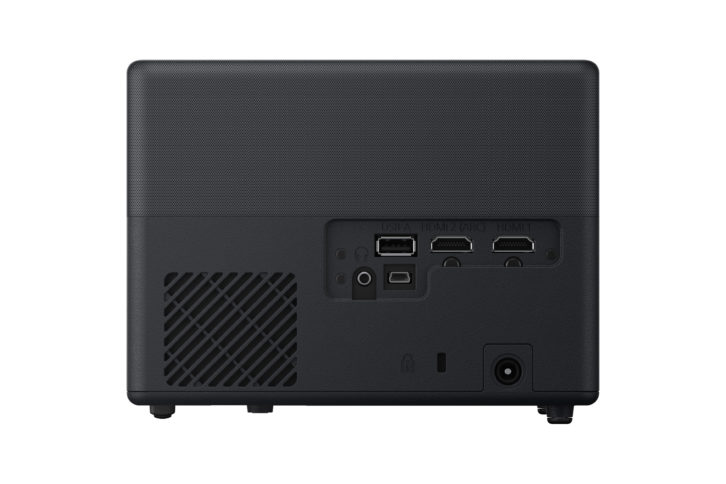
The saving grace is the corner adjustment feature that is awesome. This reminded me a bit of some of the settings available when calibrating CRT projectors, but way quicker and easier. Here you can tweak the image in eight locations, helping get an image that is perfectly square and level. Fortunately, making corner adjustments is easy enough that an end-user could easily perform the adjustments as well.
As mentioned, there are some top-mounted controls, but these are super-limited essentially power, volume up/down, Bluetooth mode, and “Blank” that turns the image o
ff. if you lose the remote, you’re sunk and can’t even change inputs. a home/menu button with D-pad control on top would have been a nice backup solution.
It feels like the whole world is transitioning to streaming, and this projector is ready with Android TV built-in. of course, taking advantage of all android has to offer means signing in with a Google account, but that’s just about par for the course anymore. It’s great that you can re-order and position apps on the home screen, making favorites easier to find and access. Enough people are familiar with the Android TV experience that they should be right at home in navigating.
The EF12 Supported nearly every app we regularly use, including Disney+, Dish Anywhere, Vudu, Hulu, YouTube, and Amazon Prime Video, along with plenty of other familiar ones like Paramount+, HBO max, Peacock, and many more. Searching and installing additional app0s is a simple process by just navigating to the Google Play store.
Interestingly, the projector’s Vudu app is (currently) limited to only displaying SD content. But by using y phone and Chromecasting content from Vudu, I could watch the noticeably better-looking HD or HDX versions.
One thing…. and this is kind of a big one. The Ef12’s built-in Android TV does not support Netflix. Not even via Chromecast. According to Epson, “Users cannot run, install, or cast Netflix at this time. Epson is currently working on hardware certifications and licensing agreements with Netflix. At this time, the app can be used on the EF12 via third-party
streaming media players from Apple, Roku, Nvidia, etc. [or] you can plug in your own Chromecast device and cast Netflix to the EF12 that way. When new services are certified, they will be added via automatic Android TV system updates.”
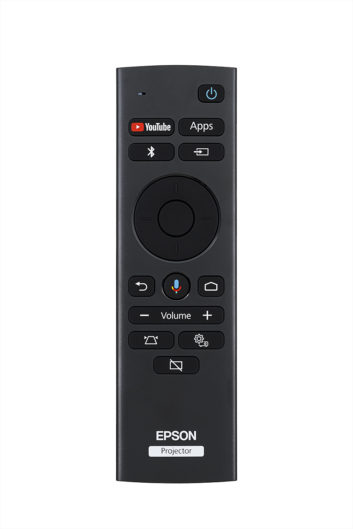
So, year. No built-in Netflix. :/
The remote is basic, but serviceable. Of course, I wish it would include some backlighting for easier use in a dark room, but there aren’t a lot of buttons and the layout is fairly intuitive. The remote does have a YouTube button for jumping straight into that app. It does include a microphone for Google Assistant, and being able to say things like “Open Disney Plus” or “Open Movies Anywhere,” or searching for programs across apps, as well as asking for normal queries like the upcoming weather, or turning off lights already tied to my account was great. Though I did find this remote’s mic to have more difficulty in understanding than usual, for example, asking it to find Pixar’s new film Luca repeatedly returned video results for “Hookah.”: Maybe Google was trying to tell me something…
Finally, while the Epson is portable, it does not have any kind of internal battery, requiring a constant AC connection to function. If your install requires something truly portable, you’ll want to keep that in mind.
In Use
At 1000 lumens, the EF12 puts out a decently bright image- especially at smaller image sizes– but it definitely looks its best in a dark environment, especially when using the “Natural” picture mode where it delivers its most accurate colours. In a home this was less of an issue, but when watching outside where you lively have little control over the ambient lighting, such as neighborhood street lights or just moonlight, it could look a little washed out.
The lens offers enough resolution to deliver pixel-sharp detail, helping you to get a nice, tight focus though there is a bit of colour fringing noticeable on white text, and the 1080p resolution offers tons of detail. With a rated contrast of 200,000:1, black levels (in a darkened room) were not truly black, but certainly dark enough to deliver nice contrast.
Bright content definitely plays to the EF12’s strengths, and things like Pixar’s Luca and Soul via Disney+ produced really bright and vibrant colours with nice punch, even when the room wasn’t its darkest. It was also great watching Euro Cup soccer matches and Wimbledon via my Dish Anywhere app, with the green of the pitch/court giving high visibility, and the EF12’s motion handling doing an admirable job with the action. With the light off and firing on a good surface (such as my Draper screen), the projector delivered a really enjoyable cinematic experience even with dark films like Blade Runner 2049.
While the unit features native 1920×1080 resolution, the HDMI inputs are HDCP 2.3 and capable of accepting true 4K HDR signals. Even though there is no resolution improvement, it was nice to be able to connect my Kaleidescape Strato and Apple TV 4K and not have to go through a whole reconfiguration process.
The laser light engine offers super-quick power on/off times, going from standby to an image onscreen in about five seconds, and powering off even more quickly. Also, with its rated lifespan of 20,000 hours, you won’t have to worry about kids using it like a TV, turning it on/off repeatedly or leaving it on by mistake. As with any laser, do not look into the lens as it can damage your eyes. In fact, it actually killed a big that happened to fly up and land next to it!
Another real high-point of the EF12 is the included 5-watt stereo audio system by Yamaha that sounds shockingly good. With this, the projector easily delivered enough volume- with peaks exceeding 90 dB at 1m- to be entertaining and audible, especially when seated behind the projector where the speakers are located. Dialog was also clear and easy to understand, and it actually produces bass that has some depth. Outside it was a bit more of a challenge, with the wide-open spaces and louder noise floor, but it was still enough for us to enjoy. For regular outdoor entertaining, you would probably want to utilize the audio output to drive an external sound system to deliver big sound that matched the big picture.
The Ef12 can receive Bluetooth audio, or connect to an external Bluetooth speaker through the Android TV interface. So if you want to use it as an audio-only speaker, you’re in luck.
I used the EF12 in a variety of locations, both inside and outside my house and at my showroom, and this is definitely the EF12’s killer app; being light enough to just grab and move around, quickly plopping it down, and setting it wherever you want to enjoy a movie, with the built-in apps providing all the entertainment you need.
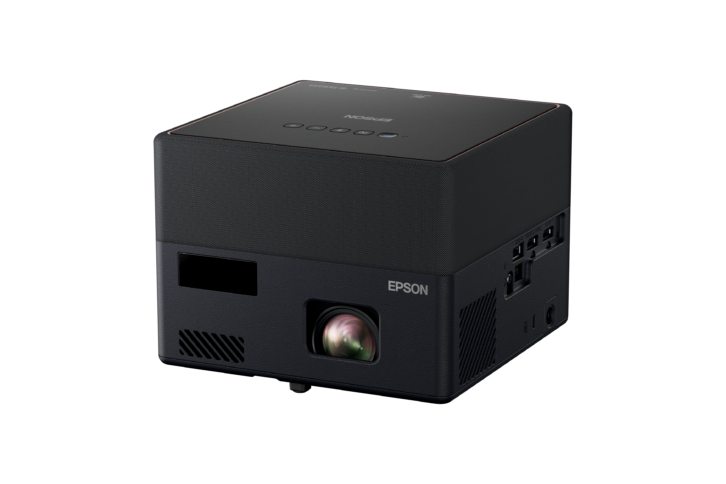
I don’t want my daughter to have a TV in her room, but letting her setup the EF12 for a sleepover and turn nearly her entire wall (or ceiling) into a screen was a huge hit. As was setting it up in our driveway and enjoying a summer “drive-in” projecting onto our garage door and connection to my iPhone’s Wi-Fi hotspot for streaming. Or taking it on vacations for an end-of-day hotel movie night. Did anyone care that the colour accuracy was biased by the wall colour, or that there were visible seams from the garage door? Hardly. With the EF12 you are read to turn any flat surface into your own movie theatre.
While I wouldn’t consider this for a dedicated media room (it was noticeably lacking compared with my reference JVC NX-7, though only costing 11 percent as much), that isn’t what the Epson EpiqVision EF12 is about. Blasting a 150-inch movie onto a wall, sheet, or house is where this excels, and where the EF12 shines over other projectors.
Outdoor entertaining is an increasingly growing category, and the video side of hat equation often falls to just using a medium-sized flat panel. With the Epson EpiqVision EF12, you can easily tote the projector out for an evening, plop in onto a table or tripod, stream something from the included Android TV, and bring it back in when done. And, as an added benefit, you can even purchase it through your regular Epson distribution partner. And at under $1000 it might be the centerpiece of a much larger outdoor entertainment solution.
